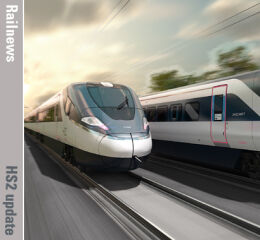Posted 2nd January 2024 | 4 Comments
New Year will be ‘pivotal’ for HS2

HS2 Ltd is preparing for a ‘critical new phase’ as work on the surviving section of Phase 1 between Old Oak Common in west London and Birmingham Curzon Street is stepped up, with an investment of £5 billion in new contracts planned for 2024.
The last 12 months have not been happy ones for the project, which suffered the loss of Phases 2A and 2B north of the West Midlands to Crewe and Manchester when the Prime Minister cancelled them on 4 October, along with the last spur towards the East Midlands.
Controversy continues over the fate of the land and properties which had already been purchased for the section to Crewe, as well as the poorly-received ‘Network North’ plan for alternative transport schemes which would use the £36 billion released by the cancellation. There is also uncertainty about whether HS2 will ever reach its intended terminus at London Euston.
Rolling stock has encountered problems as well. The Department for Transport had attempted to provide only one door on each vehicle, and is now said to be negotiating a costly revised specification for two doors with the rolling stock manufacturers Hitachi and Alstom. Alstom, meanwhile, is poised to close its Litchurch Lane works in Derby, partly because of the reduction in size of the HS2 rolling stock contract, and a decision may be made within weeks.
Even so, the remaining part of HS2 will include new contracts this year which will involve track, power, signalling, overhead lines and the new network control centre.
HS2 Ltd, which described its plans for this year as ‘pivotal’ said the forthcoming work ‘will be constructed to the highest standards to help create a new benchmark for speed and punctuality, ensuring passengers can rely on the service, even in the face of extreme weather’.
Other contracts will include a new telecom system that will provide an uninterrupted mobile signal on board the trains, even in the project’s many tunnels.
Over the past year, HS2 has seen the start of work on the first of 14 new platforms at Old Oak Common, the completion of HS2’s first twin-bore tunnel beneath Long Itchington Wood in Warwickshire, the launch of the first of two tunnel boring machines for the Bromford tunnel on the approach to Birmingham, and the half way point reached on the Colne Valley viaduct, which will be 3.3km long.
It was also confirmed that HS2’s workforce had passed the 30,000-mark.
HS2 Ltd executive chair Sir Jon Thompson said: ‘This is a project of phenomenal scale and ambition and we’re immensely proud of the progress made between London and the West Midlands throughout 2023. There will be no let-up in delivery in 2024.
‘The transition in our focus towards railway systems represents another significant milestone and will edge us ever closer towards bringing this transformational project to life.’
Reader Comments:
Views expressed in submitted comments are that of the author, and not necessarily shared by Railnews.

Michael T., Reading, Berks
The Press, Media, and non-Tory Politicians etc should stop speaking of HS2, HS3, HSAir, etc so dismissively. Just because a small group of tory imbeciles have tried to Poison the Well in the run up to the on-coming tory free Parliament... ANY other person or Political Party who is elected this year will Most Certainly REINSTATE this highly essential project.
IF anything, Rishi Rich (cartoon for those who remember)... Personal Decision to axe HS2 etc will have the affect of generating MORE public Support for the HS2 project.
There would never have been such a typical English Sickness ... anti-anything NEW... IF the HS2 path between London Euston and the Crewe area, it was simply a dashed, dotted, etc line in same colour pattern as the WCML and displayed on the NON-Geographic Maps (most people can not read a map...). People would have seen HS2 for what it is... the adding of a FAST Up and FAST Down pair of tracks that on the WCML have it adjacent to existing non-geographic WCML with the only thing being different to the 'under construction demarcations' route.
david C smith, Bletchley
If we give the points made by Prof.McNaughton, i assume the HS2 dedicated stock would still be slower once off HS 2 onto existng lines ?
And if the infrastructure costs don't vary much beween 155 and 225 mph , would we still have needed all this tunnelling ?
Given that tilt mechanism is an extra cost, it would be likely that non tilting stock capable of 225 mph would incur additional costs anyway.
And think of all those people living further North than Manchster too.
Martin Sloman, Ellesmere Port
Professor Andrew McNaughton - who was technical director of HS2 – has made the point that increasing speed on the route did not increase costs in proportion and that the alignment would have been much the same had a much lower linespeed been chosen e.g. 300km/h (186mph). Tilt is now seen as old technology and it is believed that similar speeds can be achieved on existing infrastructure with modern rolling stock - bearing in mind that the tilt mechanism adds to the weight of rail vehicles. So, there would not be any great advantage in reducing the main HS2 linespeed.
david C smith, Bletchley
Has it occurred to our decision makers that the specification for HS2 was innappropriate from the start ?
Is stock that is 225mph capable on HS2 with a sub- 125mph non- tilting limit on conventional infrastructure a sensible aim ? ( trains via HS2 to Glasgow , Newcastle, Edinburgh , Leeds etc.) Such services would have lost at least nearly all their time advantage , once off HS2.
Assuming a capacity boost still needed, would it have been more cost - effective to have built it to a lesser maximum speed, and bring in the newest 155mph version of "Pendolinos" that aleady see service on the Continent ?